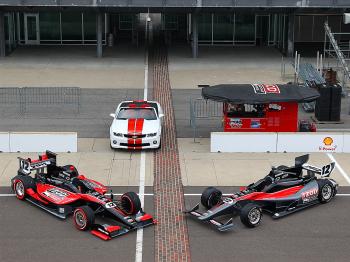Feeding fan curiosity for the 2012 season, IndyCar unveiled two possible versions its brand-new chassis today at the Indianapolis Motor Speedway, home of the Indy 500.
The two very different looking cars showed how future IndyCars can be adjusted to suit different track types.
The new cars, which will replace the 11-year-old Dallara IR3, demonstrate the new direction IndyCar will be taking next season. The cars start with a “safety cell”—the basic monocoque, front wing, and suspension—to which is added more than two dozen aerodynamic pieces—basically, all the bodywork and the rear wing.
Tony Cottman, IndyCar’s project manager for the 20102 vehicle, explained the ideas underlying the two different cars.
“The idea behind these is to show two totally different-looking vehicles that underneath are the same chassis,” Cottman in a press release. “There is a lot of room for aerodynamic kit development and that’s what this platform is about—allowing people the freedom to design as they wish, dream as they wish and come up with a superior product than others. That’s what drives competition.
One of IndyCar’s claims to fame is that it runs on many different types of racetracks: ovals, road courses, and street circuits, all of which demand different aerodynamic performance. Starting in 2012 teams will have two different collections of bodywork—called “aero kits” to suit the different types of tracks.
The cars revealed in Indianapolis today showed a possible oval configuration and a possible road kit. Both were designed by Dallara, which will be the sole manufacturer of the safety cell.
One of the innovations coming in 2012 will be the ability of outside companies—Chevrolet, Lotus, Honda and perhaps others—to design and build their own aero kits. This will ensure that the cars not only look different from one another, they will perform differently, as different designers will seek to maximize different aspects.
[etssp 362]After years of seeing a grid full of identical Dallaras, fans showed in polling that their primary desire was for a return to different designs, and the competition between designers that that engenders. For 2012, fans will get their wish.
Another benefit of the new chassis is that it will be much cheaper t o purchase and operate. With the old IR3, teams had to swap suspension and bodywork pieces for different types of tracks, which meant they had to have twice as many parts on hand, for road and oval tracks.
The new car was designed to work well on all racetracks, with adjustable suspension parts instead of entirely different suspensions for each race.
The two very different looking cars showed how future IndyCars can be adjusted to suit different track types.
The new cars, which will replace the 11-year-old Dallara IR3, demonstrate the new direction IndyCar will be taking next season. The cars start with a “safety cell”—the basic monocoque, front wing, and suspension—to which is added more than two dozen aerodynamic pieces—basically, all the bodywork and the rear wing.
Tony Cottman, IndyCar’s project manager for the 20102 vehicle, explained the ideas underlying the two different cars.
“The idea behind these is to show two totally different-looking vehicles that underneath are the same chassis,” Cottman in a press release. “There is a lot of room for aerodynamic kit development and that’s what this platform is about—allowing people the freedom to design as they wish, dream as they wish and come up with a superior product than others. That’s what drives competition.
One of IndyCar’s claims to fame is that it runs on many different types of racetracks: ovals, road courses, and street circuits, all of which demand different aerodynamic performance. Starting in 2012 teams will have two different collections of bodywork—called “aero kits” to suit the different types of tracks.
The cars revealed in Indianapolis today showed a possible oval configuration and a possible road kit. Both were designed by Dallara, which will be the sole manufacturer of the safety cell.
Auto Manufacturer Involvement
One of the innovations coming in 2012 will be the ability of outside companies—Chevrolet, Lotus, Honda and perhaps others—to design and build their own aero kits. This will ensure that the cars not only look different from one another, they will perform differently, as different designers will seek to maximize different aspects.
[etssp 362]After years of seeing a grid full of identical Dallaras, fans showed in polling that their primary desire was for a return to different designs, and the competition between designers that that engenders. For 2012, fans will get their wish.
Another benefit of the new chassis is that it will be much cheaper t o purchase and operate. With the old IR3, teams had to swap suspension and bodywork pieces for different types of tracks, which meant they had to have twice as many parts on hand, for road and oval tracks.
The new car was designed to work well on all racetracks, with adjustable suspension parts instead of entirely different suspensions for each race.






